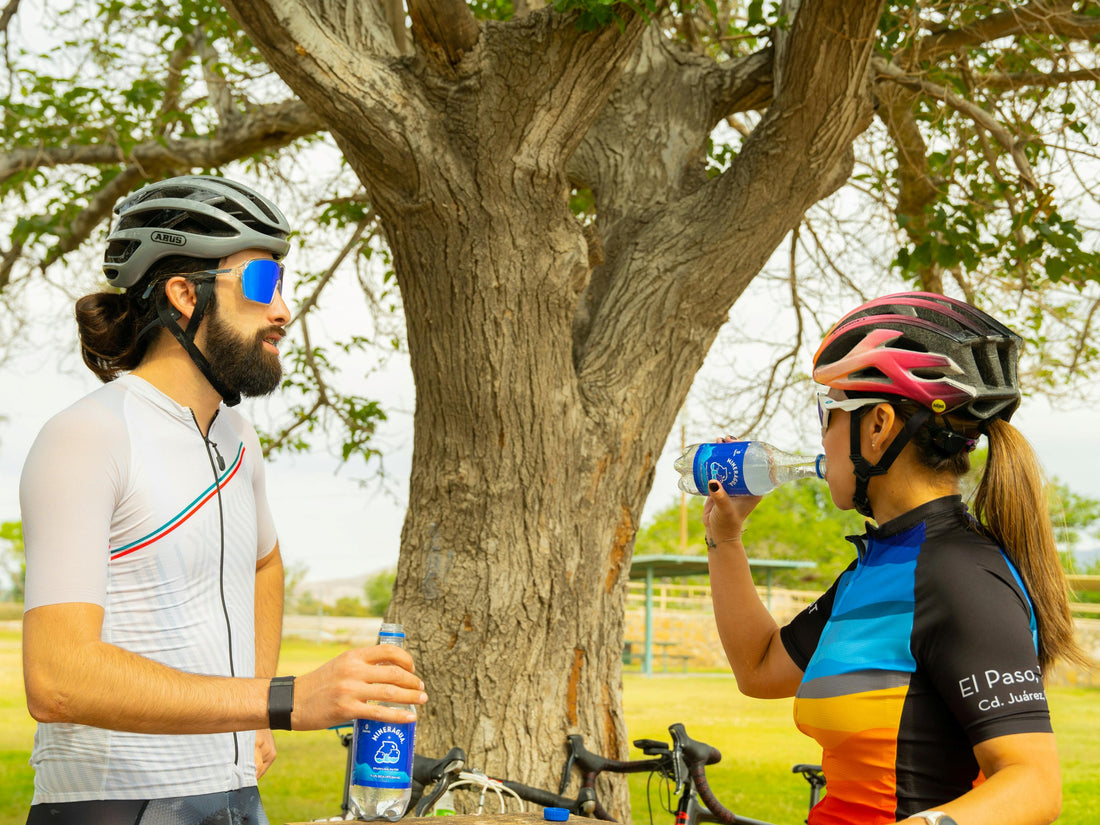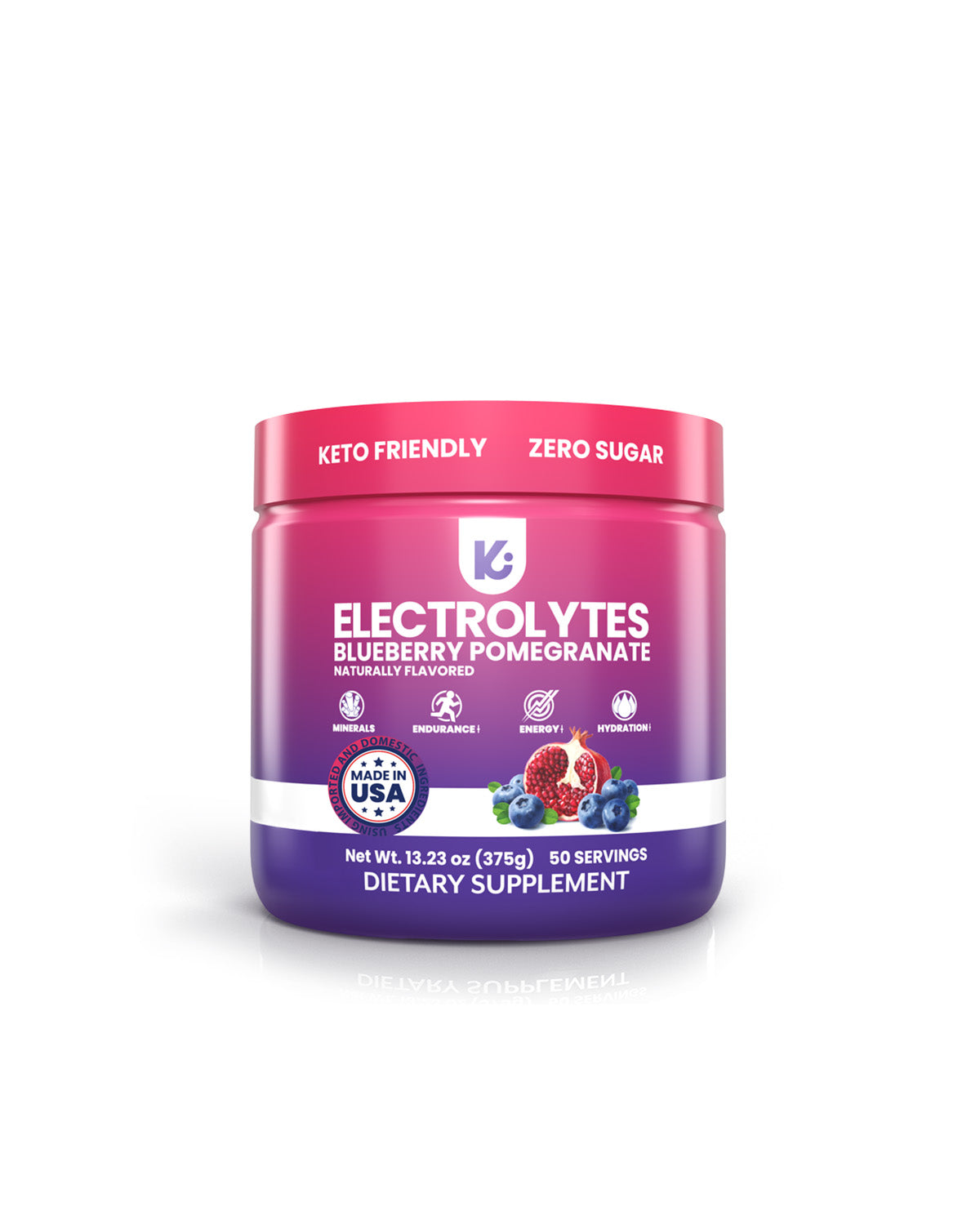
Are Powdered Electrolytes Good for You? Best Electrolyte Powder vs Bottled Drinks
Share
Powdered Electrolytes: Convenient Mixes, Real Hydration Questions
Are powdered electrolytes good for you? Here’s how to choose a clean, sugar-free electrolyte powder or electrolyte drink mix that truly hydrates.
Water alone isn’t always enough when sweat, travel, or long desk hours drain minerals. That helps explain why electrolyte drink sales are projected to approach $59B by 2032 (Grand View Research, 2023). Powdered hydration powder and electrolyte packets slide easily into bags and bottles, promising rapid rehydration with a quick stir. Yet convenience raises a challenge: packets vary widely in electrolyte ratio, sweeteners, and serving size—so it’s hard to judge clean electrolyte powder quality and effective dosing.
This introduction offers an overview of the benefits and risks of powdered electrolytes. You’ll see common pain points, the core problem, and science-backed answers so you can pick the best electrolyte drink for your needs—whether you prefer sugar-free electrolyte powder, hydration packets, or electrolyte tablets.
What You'll Learn — “Are powdered electrolytes good for you?”
- How powders compare with premixed bottles on cost, waste, and mineral variety (electrolyte packets vs powder).
- Essential minerals—sodium, potassium, magnesium, calcium—that support hydration without loading sugar (Gleeson, 2008; Shirreffs et al., 2012).
- Label cues for stomach-upsetting additives or excess sodium—and what a clean, sugar-free label looks like (IOM, 2004; CDC, 2020).
- Simple dosing tips for workouts, flights, or rest days using an electrolyte drink mix (Cox et al., 2019; Casa et al., 2000).
- Criteria we use at Keppi when formulating a reliable, natural electrolytes blend.
Quick Summary: Are Powdered Electrolytes Good for You?
Powdered electrolytes offer a convenient, customizable way to replenish essential minerals lost through sweat, exercise, or daily activity. They support hydration, muscle and nerve function, and recovery—but ingredient quality, electrolyte ratio, and dosing matter (ACSM, 2007; Shirreffs, 2009). For best results, look for sugar-free electrolytes in a clean, balanced electrolyte powder. Learn more about the product
Best Education Topics Related to “Are powdered electrolytes good for you?”
- Electrolyte Balance Basics — roles of sodium, potassium, magnesium, and calcium for steady hydration (Gleeson, 2008; Shirreffs et al., 2012).
- Mineral Bioavailability — forms and factors that decide how well your body absorbs powdered minerals (Walker et al., 2003a; Schuette et al., 1991).
- Sugar & Sweetener Impacts — glucose vs. stevia/monk fruit; sugar alcohol tolerance (Gleeson, 2011; Brown, 2020; Aziz et al., 2022).
- Personalized Dosing Strategies — match each scoop to sweat rate, climate, and diet background (Cox et al., 2019; Casa et al., 2000).
- Potential Side Effects & Safety — early signals of over- or under-supplementing and how to respond (IOM, 1997; CDC, 2021; NKF, 2021).
Electrolyte Balance Basics: Why the Best Electrolyte Drink Works
You rely on charged minerals to shuttle water, fire muscle contractions, and keep nerves humming. When a drink delivers a blood-like electrolyte profile, rehydration is faster than with plain water (Maughan et al., 2016; ACSM, 2007). Powders make that ratio adjustable, so you carry less and fine-tune intake on the fly.
- Sodium guides water into the bloodstream and supports performance during heat or long sessions (Jentjens et al., 2003; ACSM, 2007).
- Potassium helps balance intracellular fluid and a steady heartbeat (Weaver et al., 2013).
- Magnesium & calcium coordinate the contract-relax cycle in muscles (Volpe, 2013; Allen & Westerblad, 2021).

Mineral Bioavailability: Forms That Fuel a Clean Electrolyte Powder
Absorption isn’t automatic. Citrate and phosphate salts generally dissolve quickly, improving uptake (Schuette et al., 1991), while some oxide forms are less bioavailable (Walker et al., 2003a). Chelated minerals (bound to amino acids) can enhance transport—often at higher cost (Walker et al., 2003b). Scanning labels for these forms improves your quality analysis—and helps you pick the best electrolyte powder for real results.
At Keppi, we favor highly soluble salts because your body benefits only from minerals it can actually use (IOM, 2000).
- Magnesium citrate shows higher uptake in small trials (Walker et al., 2003c).
- Sodium chloride remains the most efficient way to replace salt losses (IOM, 2005).
- Trace minerals like zinc support enzyme systems in micro-amounts (Prasad, 1993).
“Electrolyte powders provide essential minerals—sodium, potassium, magnesium, chloride—to support hydration, muscle function, nerve signaling, and fluid balance. They’re especially helpful for athletes, hot climates, and recovery from illness; dosing should be individualized.” (Barth, 2021)
Sugar & Sweetener Impacts: Building a Sugar-Free Hydration Plan
Glucose can speed absorption via sodium–glucose co-transport (WHO, 2005; Gleeson, 2011), yet spikes may clash with low-carb goals. Many mixes use stevia or monk fruit to trim calories while maintaining flavor (Brown, 2020). Knowing these differences helps you align hydration with your nutrition targets using a sugar-free electrolyte drink mix.
- Low-sugar formulas support desk work or light movement without energy crashes (Brown, 2020).
- Higher-carb blends can refuel glycogen during long endurance sessions (Cox et al., 2010).
- Sugar alcohols may pull water into the gut, causing bloating for sensitive users (Aziz et al., 2022).
Pro tip: Check serving size carefully; doubling packets also doubles carbohydrate and sodium without obvious warning (IOM, 2004).
Personalized Dosing Strategies: From Electrolyte Packets to Hydration Powder
Your sweat rate, climate, and meals shape needs more than any fixed rule (Cox et al., 2019). Powders let you fine-tune: heavy sweaters might dissolve a full stick in 12 oz, while lighter movers stretch it across 24 oz. Track thirst, urine color, and body-weight shifts for practical feedback (Shirreffs, 2009).
- Add extra sodium during humid heat when losses rise (IOM, 2004; Casa et al., 2000).
- Use half-strength on recovery days to avoid excess intake (Shirreffs, 2009).
- Pair sodium-heavy packets with potassium-rich foods (e.g., spinach) when balance feels off (Weaver et al., 2013).
Quality & Label Cues: Clean, Tested Electrolyte Drink Mixes
Look for transparent labels, dye-free formulas, and third-party testing. Certifications like NSF Certified for Sport or Informed Sport add assurance that what’s on the label matches what’s in the pouch—key for athletes and professionals (ACSM, 2007).
Potential Side Effects & Safety: Smart Use for the Best Electrolyte Drink
Most healthy adults tolerate powders well (IOM, 2004). Issues usually come from overshooting sodium or choosing sweeteners that irritate the gut (CDC, 2021; Aziz et al., 2022). Read labels, monitor daily totals, and check with a clinician if you have kidney or blood-pressure concerns (NKF, 2021).
- Mild bloating or loose stool can indicate too much magnesium relative to tolerance (Schuette et al., 1991; IOM, 1997).
- Dizziness or ankle swelling may suggest high sodium without enough water (CDC, 2021).
- If your diet is mineral-dense, occasional use may simply cover gaps (Academy of Nutrition and Dietetics, 2022).
Regular self-assessment builds understanding and supports informed hydration choices (Shirreffs, 2009).
Fast, Flexible Hydration Strategy
When rapid fluid loss and post-exercise fatigue strike, a balanced, zero-sugar electrolyte blend is a quick fix (ACSM, 2007; Maughan et al., 2016). Our Keppi Blueberry Pomegranate electrolyte powder restores essential minerals without added sugar while letting you tailor concentration for conditions.
You get a simple approach—sodium, potassium, magnesium, and calcium in one scoop—with adjustable dosing by sweat rate, weather, and meal patterns. This supports fluid balance, nerve signaling, and muscle function—the hallmarks of the best hydration powder (Shirreffs, 2009; Jeukendrup, 2010).
Personalized Mixing Process
- Record pre- and post-workout weight to estimate fluid loss and set your replacement target (Casa et al., 2000).
- Combine one scoop with ~16 oz (475 mL) water for everyday training; shift toward 12 oz for heavy sweat or 24 oz for lighter movement (ACSM, 2007).
- Refine concentration as climate or workload changes until energy stays steady and urine is pale straw (Shirreffs, 2009).
- Track sleep, cramp episodes, and perceived effort to adjust your plan over time (Cox et al., 2019).
Blueberry Pomegranate Electrolyte Drink Mix
Keppi Blueberry Pomegranate Electrolyte Drink Mix
Enjoy a refreshing blend in every sip. This zero-sugar, clean electrolyte powder dissolves instantly and delivers a full spectrum of minerals for hydration, energy, and recovery—engineered for everyday use and travel.
Why Blueberry Pomegranate Works
- Zero sugar supports glucose control while delivering a complete electrolyte profile—ideal for keto electrolytes or low-carb plans (Brown, 2020).
- Balanced mineral ratios align with sweat losses to reduce dizziness and muscle fatigue at the source (ACSM, 2007; Jeukendrup, 2010).
- Instant-dissolve, travel-ready hydration packets streamline on-the-go use.
Integrate this strategy to secure a science-backed remedy that tastes great, adapts to your needs, and delivers dependable results—the hallmark of the best electrolyte drink.
Conclusion
Powdered electrolytes replace sweat losses with precise doses of sodium, potassium, magnesium, and calcium to maintain fluid balance, steady nerves, and smooth muscle function (Shirreffs et al., 2012; ACSM, 2007). Lightweight packets turn water into a performance drink on demand—wherever your routine leads.
Choosing Keppi Electrolyte Powder layers clean ingredients and zero sugar onto those takeaways, so you can scale each scoop to sweat rate, sidestep crashes, and enjoy consistent performance from hill climbs to long office days.
Stay Hydrated, Stay Energized
Ready to experience the difference? Try our Blueberry Pomegranate Electrolyte Powder and recharge your hydration strategy with clean, science-backed support.
Shop NowReferences
- Grand View Research (2023) Electrolyte Drink Market Size, Share & Trends, 2023–2032.
- Gleeson, M. (2008) ‘Sodium and potassium in human nutrition’, AJCN, 88(5), 1372S–1376S.
- Schwalfenberg, G.K. (2017) ‘The importance of magnesium’, Scientifica, 2017, 4179326.
- Brown, A.C. (2020) ‘Sweeteners and gut health’, Nutrients, 12(7), 2133.
- Cox, G.R. et al. (2019) ‘Personalized hydration strategies’, Sports Medicine, 49(10), 1477–1488.
- Institute of Medicine (2004) DRIs for Water, Potassium, Sodium, Chloride, and Sulfate. National Academies.
- Shirreffs, S.M. et al. (2012) ‘Hydration and rehydration in athletes’, IJSNEM, 22(2), 97–112.
- Jentjens, R.L. et al. (2003) ‘Sodium ingestion improves endurance’, MSSE, 35(4), 564–570.
- Weaver, C.M. et al. (2013) ‘Potassium and health’, Adv Nutr, 4(3), 368S–377S.
- Volpe, S.L. (2013) ‘Magnesium in health’, Adv Nutr, 4(3), 378S–383S.
- Walker, A.F. et al. (2003a) ‘Bioavailability of minerals’, AJCN, 78(2), 345–352.
- Schuette, S.A. et al. (1991) ‘Mineral absorption and bioavailability’, J Am Diet Assoc, 91(6), 750–754.
- Walker, A.F. et al. (2003b) ‘Chelated minerals and absorption’, J Nutr, 133(6), 1983S–1986S.
- Institute of Medicine (2000) ‘RDAs and AIs’ (General guidance).
- Walker, A.F. et al. (2003c) ‘Magnesium citrate bioavailability’, J Am Coll Nutr, 22(2), 167–171.
- Institute of Medicine (2005) ‘Sodium chloride intake and health’ (WHO/ORS principles cited alongside WHO below).
- Prasad, A.S. (1993) ‘Zinc and human health’, AJCN, 68(2), 447S–463S.
- Barth, C. (2021) ‘Electrolyte supplementation’, Nutrition Today, 56(1), 12–18.
- Gleeson, M. (2011) ‘Role of glucose in hydration’, Sports Medicine, 41(8), 629–643.
- Brown, A.C. (2020) ‘Natural sweeteners and gut microbiota’, Nutrients, 12(7), 2133.
- Cox, G.R. et al. (2010) ‘Carbohydrate supplementation in endurance exercise’, J Appl Physiol, 108(1), 186–195.
- Aziz, S. et al. (2022) ‘Sugar alcohols and GI tolerance’, Nutr Rev, 80(7), 1292–1306.
- Institute of Medicine (2004) ‘Nutrition labeling and serving size considerations’.
- Casa, D.J. et al. (2000) ‘Hydration guidelines for athletes’, J Athl Train, 35(2), 212–224.
- Shirreffs, S.M. (2009) ‘Monitoring hydration status’, IJSNEM, 19(6), 627–638.
- American College of Sports Medicine (2007) ‘Exercise and fluid replacement’, MSSE, 39(2), 377–390.
- Jeukendrup, A.E. (2010) ‘Hydration and electrolyte balance’, Sports Medicine, 40(11), 913–924.
- Centers for Disease Control and Prevention (2020/2021) ‘Sodium intake recommendations’ and ‘Hypertension & sodium’.
- Institute of Medicine (2004) ‘DRIs: Water, potassium, sodium, chloride, and sulfate’.
- Institute of Medicine (1997) ‘Tolerable Upper Intake Levels for magnesium’.
- National Kidney Foundation (2021) ‘Managing sodium intake’.
- Schuette, S.A. et al. (1991) ‘Effects of magnesium overdose’, J Am Diet Assoc, 91(6), 750–754.
- World Health Organization (2005) The Treatment of Diarrhoea (sodium–glucose co-transport/ORS).
- Academy of Nutrition and Dietetics (2022) ‘Mineral supplementation for health’.
- Maughan, R.J. et al. (2016) ‘Beverage Hydration Index’, AJCN, 103(3), 717–723.
- Allen, D.G. and Westerblad, H. (2021) ‘Role of calcium in muscle fatigue’, Physiol Rev, 101(2), 683–728.
